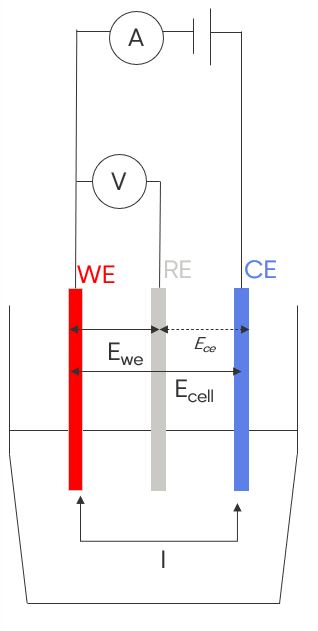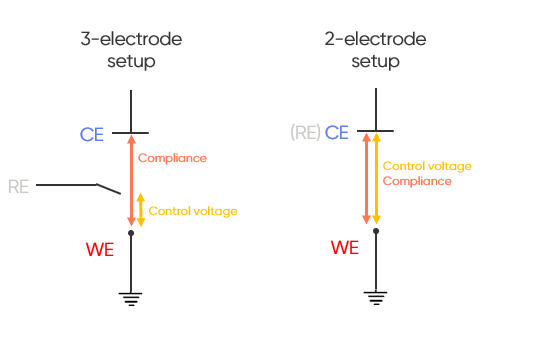What is compliance?
Latest updated: April 2, 2025Introduction
A 3-electrode setup is composed of a working electrode (WE), a counter electrode (CE) and a reference electrode (RE), the latter enables the study of the processes at each electrode separately.
In electrochemistry, the reaction takes place between the working and the counter electrode. A current flows between these electrodes, driven by a potential called the cell voltage ECELL. In general, the electrode of interest is the working electrode, and the corresponding voltage EWE is measured thanks to the reference electrode.
To guarantee that current flows as a result of potential variations at the working electrode interface, the potential of the reference electrode must remain stable and correspond to its theoretical value. One should keep in mind that no current is flowing in the reference electrode, otherwise the reference electrode is altered and it can no longer function in its role of “reference” (click here to learn how to check your reference electrode).

When performing an experiment, the user sets a desired voltage value, called “control voltage”, which in a 3-electrode setup corresponds to the voltage of interest EWE.
The potentiostat will adjust ECELL (which drives the flowing current) in order to obtain the desired control value EWE.
Note: In a 2-electrode setup, the control voltage is directly equal to the cell voltage ECELL.
What is a potentiostat? How does it work?
The potentiostat is a device able to sink or source electrical power through the counter (CE) and the working electrode (WE) of an electrochemical cell while maintaining the control of the voltage between the working and the reference electrode (RE). Learn more here.
What is compliance?
The maximum voltage that a potentiostat can manage between WE and CE to maintain the desired voltage in the cell is what we call the compliance voltage.
In a 3-electrode setup, the control voltage is EWE and the compliance voltage is ECELL.

Note: In a 2-electrode setup, the control voltage, the cell voltage and the compliance voltage are one and the same.
How to deal with compliance?
Compliance can be reached under several conditions including:
- when working with larger currents than the potentiostat is rated for,
- having significant voltage drops due to the geometry of the cell or the resistance of the solution,
- having a significant ground offset.
In this case, the potentiostat can’t properly control or measure the signal.
Here is an illustrative and interactive example. Move the blue cursor to choose the setpoint voltage EWE, and see the effect on the compliance as the voltage between the counter electrode and the working electrode increases. In this example, a large ohmic drop can be noticed, which then rapidly leads to the maximum compliance value (20 V) to be reached at a set value of only 6 V.
Live demonstrator (What is compliance (live demonstrator))
Conclusion
While researchers typically monitor the working electrode in a 3-electrode setup, they may overlook important signals from the counter electrode. When compliance voltage is reached, it can impose limitations on the experiment or stop it entirely. Being aware of what happened with your cell voltage is crucial for troubleshooting and overcoming compliance issues.
At a glance: what is the difference between control voltage and compliance voltage?
Control voltage refers to the voltage of interest, corresponding to EWE (the voltage between the working electrode and the reference electrode) in a 3-electrode setup or to ECELL (the voltage between the working and the counter electrode) in a 2-electrode setup.




